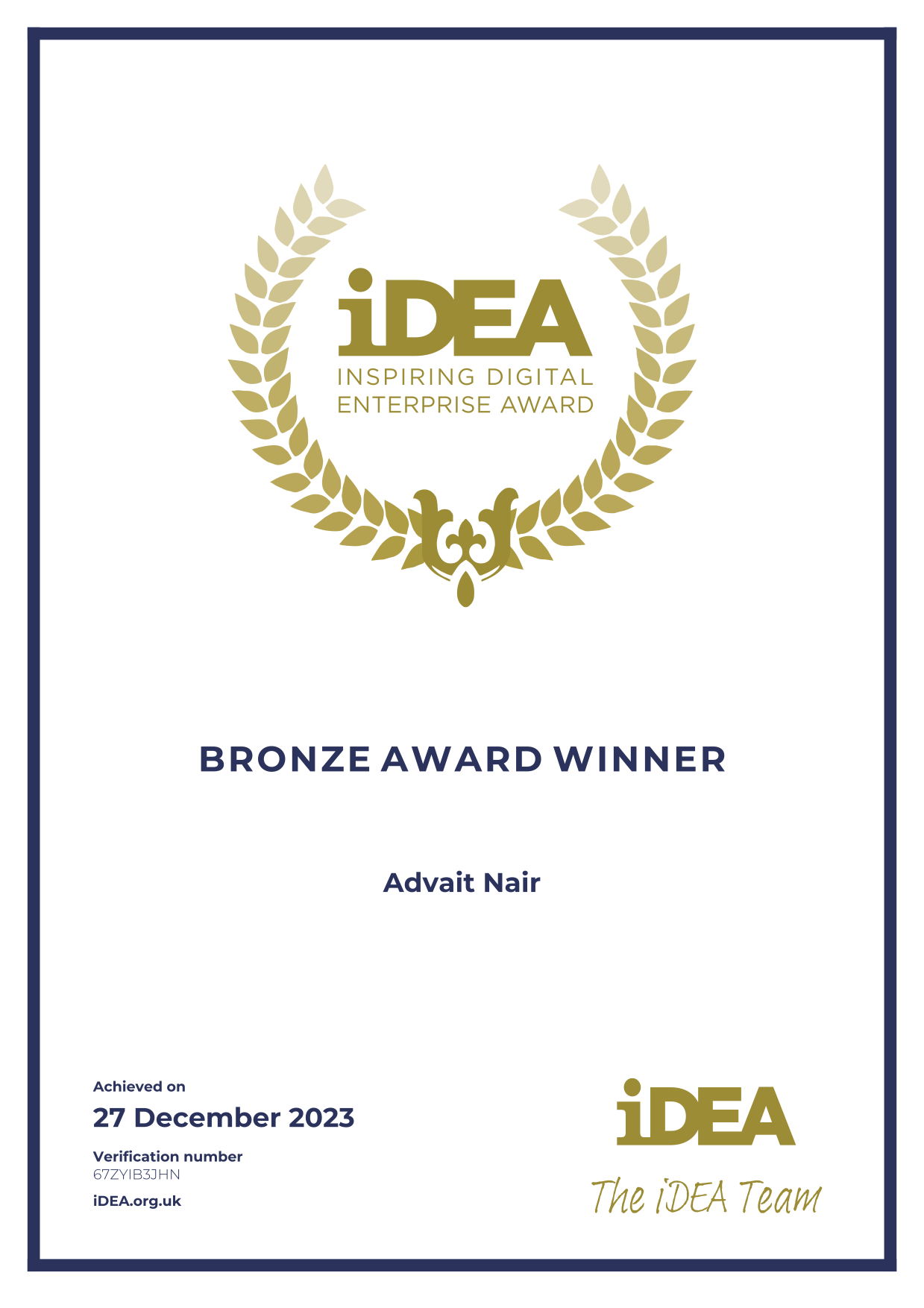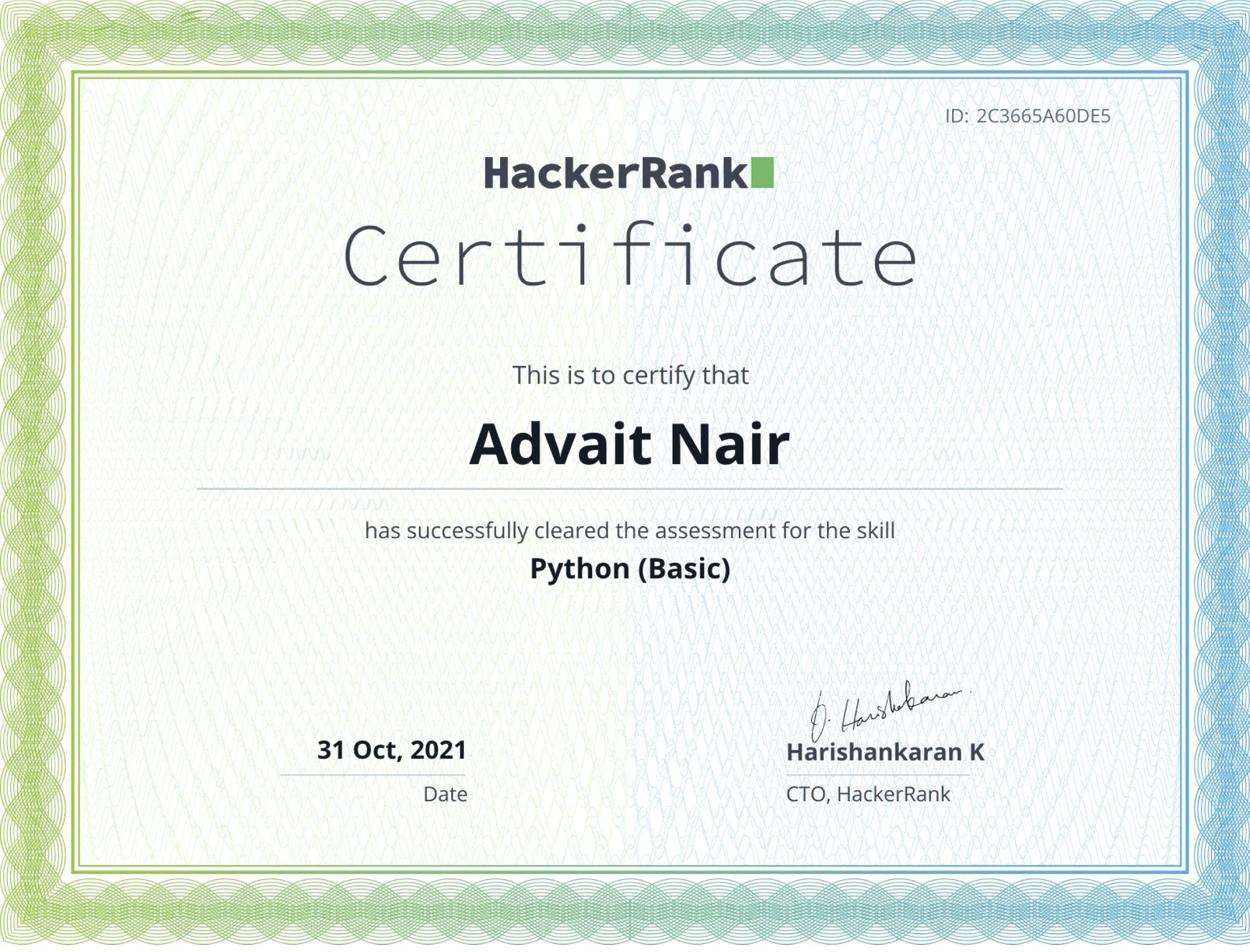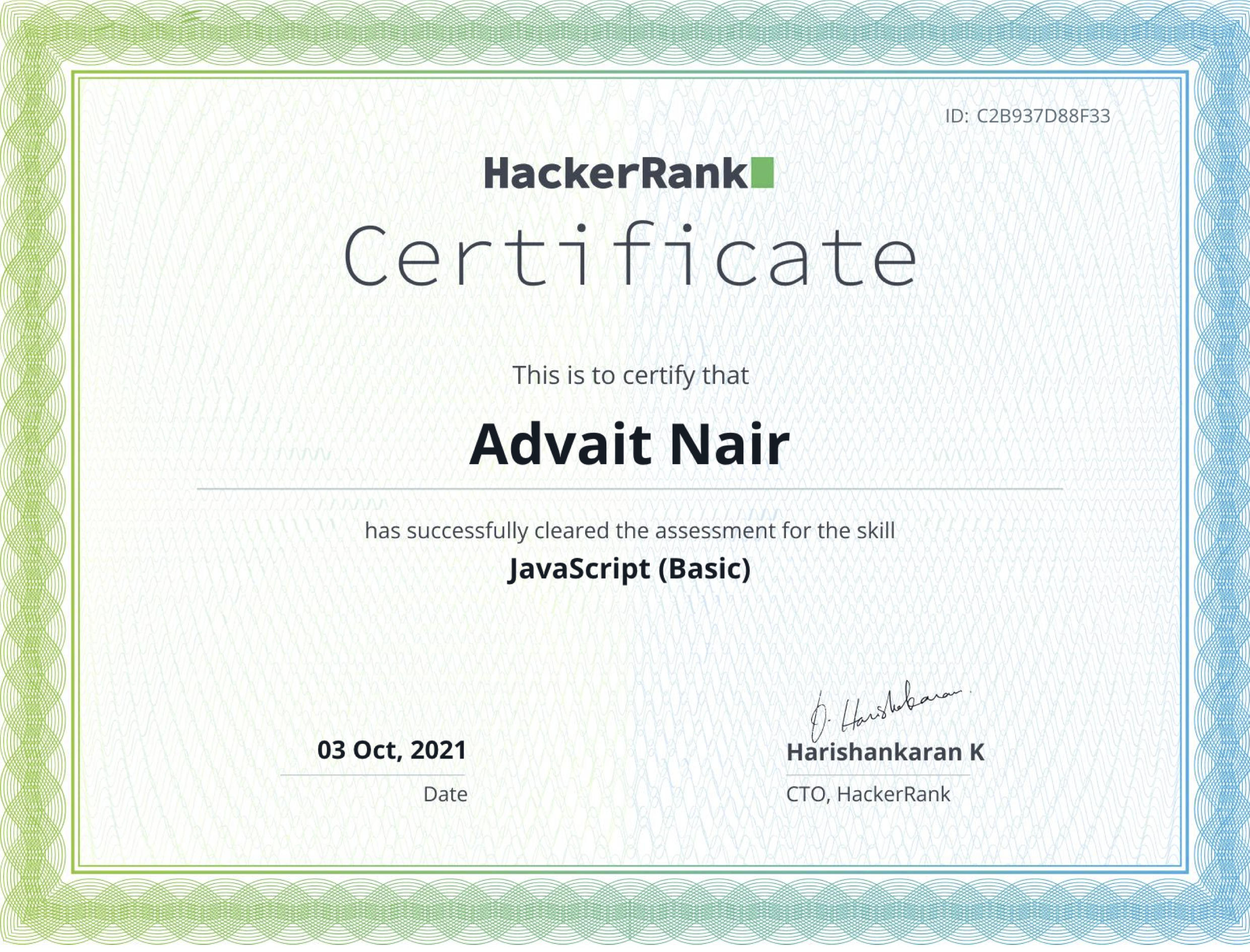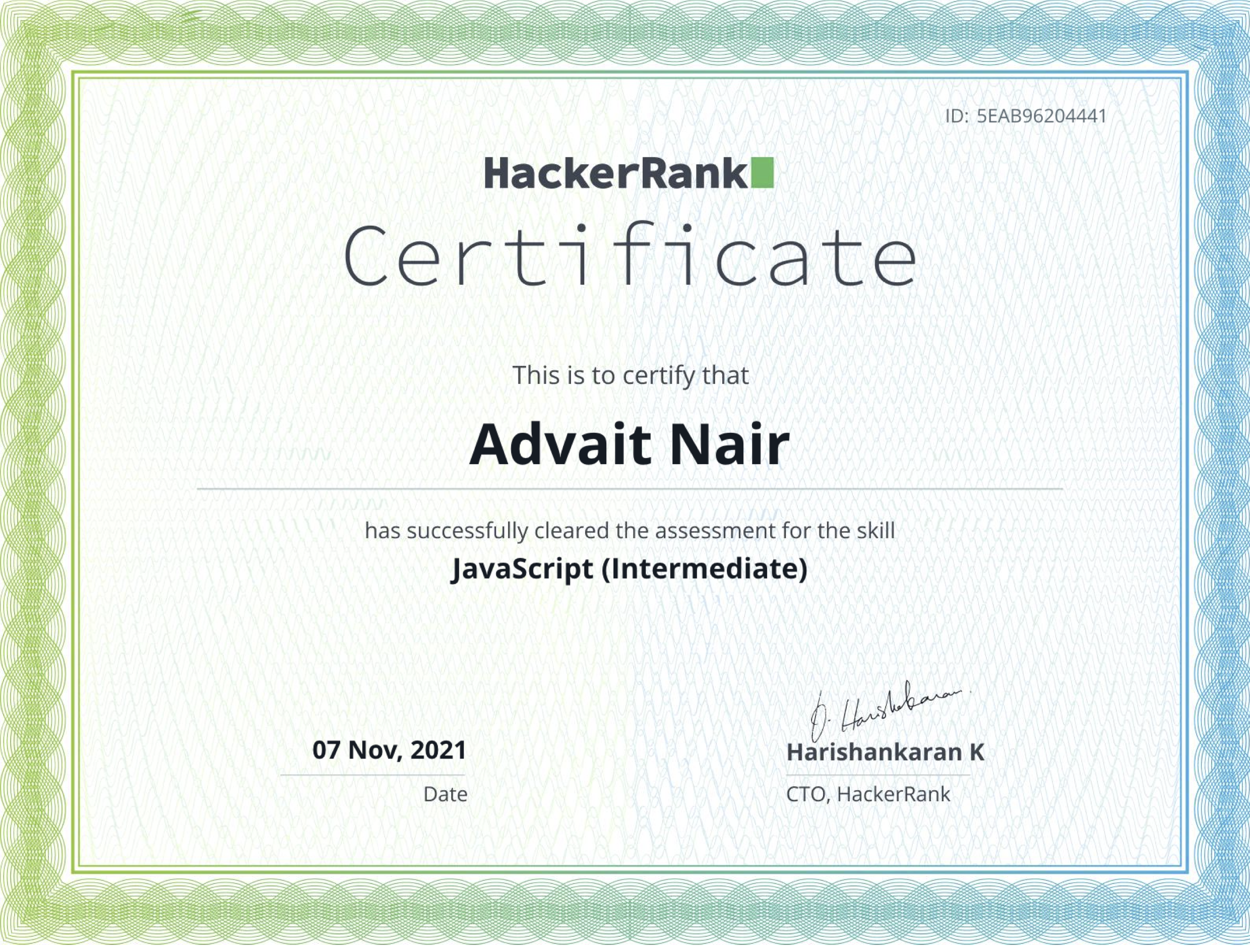Advait Nair
About Me
My name is Advait Nair. I am passionate in the fields of computer science, technology and aerospace engineering and will be doing A-Levels this year.
I have an entrepreneurial mindset, as I am open to new, changing ideas and love to apply my skills to innovative ideas and concepts to make them a reality.
I am an ambivert who enjoys working outside in an active environment but also at a desk in front of a computer. I have digital skillsets involved in the handling of computer machinery. I work with loads of digital utilities such as Visual Studio Code, GitHub, GitHub Copilot, Figma, Python IDLE, Netlify, Blender and Roblox Studio as well as programming languages and textually based interfaces such as Python, JavaScript, HTML, CSS, TypeScript, Svelte, SvelteKit and Lua.
My experience with these digital tools has allowed me to develop a complex and robust problem-solving approach to issues that occur within my workspace. This in turn speeds up my workflow and increases my productivity and efficiency greatly.
I believe that artificial intelligence will be the the primary factor in many computer and technology industry advancements, and have embraced the introduction of LLMs such as ChatGPT, Gemini, Copilot and Claude. I have integrated them closely with my workflow to maximise my productivity and efficiency, and know how to prompt, utilise and judge the output of these models. Understanding, utilising and tracking the rapid expansion of Artificial Intelligence is important to me, and I am very interested in learning in detail the technology, logic and implementation behind large-language models.
Predicted Grades
My predicted grades for Year 11 GCSEs| Subject | Predicted Grade |
|---|---|
| Maths/H | 9 |
| Science/H | 9 |
| English Literature | 7 |
| Geography | 9 |
| Computer Science | 9 |
| English Language | 9 |
| Design Technology | 9 |
| Business | 9 |
Testimonials
Testimonials of my past projects I have completed for global clients.justgohosting (UK)
Ian Campbell (iancampbell1, UK)
Keaton Garner (keatongarner97, US)
Projects
I started building websites friends & family out of passion, and it has turned into a professional service where I have worked with clients from the US, UK and India. Below are some of my past works.Adva Velo
A modern, sleek and robust journey-tracking app that tells its user various metrics during a journey. It is primarily designed for cyclists, featuring detailed route height elevation information and average speed recording, but is also usable for recording journeys on cars. Adva Velo is minimalistic, accessible and straight-to-the-point, and is completely free-to-use. User location data and personal information is kept private and not sold to third parties, and ads are not implemented into the service to enhance privacy and ease of use. I learnt to utilise many Javascript APIs (Application Programming Interfaces) including the Geolocation API, Wake Lock API, and DeviceOrientation API to retrieve real-world metrics such as velocity, slope (Angle Of Attack) and distance through computing differences between latitude and longitude coordinates. As different localities prefer different units for distance and speed, a complex and complete unit conversion system is incorporated into the application's design to allow for the internationalisation of Adva Velo. Different speed units include miles per hour (mph), kilometres per hour (kmh) and metres per second (m/s). Due to the ever-changing nature of the variables involved, a dynamic, reactive algorithm is incorporated through Svelte writable interfaces and Firebase listeners to track, identify and apply any changes to the application state, and ensure a smooth experience for the end user. To allow for multi-device syncing and capability Firebase was used to provide user authentication with Google and data retrieval, listening and storage on-cloud. Google Analytics is also implemented. The project is packaged in the form of a Progressive Web Application (PWA), meaning the website contains a high volume of metadata in a manifest.json file describing the characteristics of the application. This helps with Search Engine Optimisation (SEO) and allows for the installation of the application onto a user's device to remove the visual limitations of a browser. Many blockades were faced in the development of this project, with one of the more prominent issues involving the improper referencing of the "window" object, which required me to learn about SSR (Server-Side Rendering) and how to develop applications with this capability without throwing errors. Adva Velo was built with SvelteKit on a Node.JS runtime.
Altris Trading
A modern website I built for an Indian aluminium cabinets company, which included a scrolling product feature box, a captivating front-page and a contact solution to increase conversion. I built an SPA (Single-Page Application) with a custom search parameter navigation system, as well as a custom image carousel solution to present company products to the end user. I learnt how to register domains and link them to the Netlify DNS name servers to host the website on a FQDN (fully qualified domain name). I also integrated an email form that allows the business to receive emails directly from their website to their inbox, which increases conversion rates.
Coordinata (In Progress)
Ever wanted to host your own event? A football league, badminton open or cricket match? Coordinata makes it easy to share, manage and schedule events, as well as integrate check-in, notification and tournament systems for attendees. View and control participants and events, and use Coordinata Matchmaking to create tournament rounds and structures with the click of a few buttons. I created this app as a 'PWA', which stands for 'Progressive Web App'. This means you can download the app onto your phone and use it like a native app. Learnt how to build a large-scale application with SvelteKit and Firebase. I learnt semantic versioning (v1.1.0), Logging in with Google, SvelteKit page routes ('website.com/home', 'website.com/app', etc.), Firebase database rules (Rules controlling access of a database).
The VPS Company
A set of 3 websites I built for a client on Fiverr. I made an in-house blog system with customisable formatting (Bold, Italic, etc.), structure and styling along with 2 front pages for Web Hosting and VPS Hosting that featured and organised sales pitch, pricing views and contact information. I used a Particles.js library to create 3D effects on the front page to capitvate visual attention. The website is not public as of now.
QuickSearch
I built a simple application allowing you to search a specific website with 'tags'. For example, entering 'yt:fireship sveltekit' searches on YouTube for 'fireship sveltekit'.
Garner Solutions
A 3-page website I designed in Figma and custom-built for a client in the US in just 3 days - this required extensive time and resource management to ensure the product was received before the deadline while retaining product quality. I built a custom carousel (V1) system for the front-page which allowed the user to view various images behind the main title background, serving as visual appeal. The website was complete with responsive styling, a design scheme and formal branding. Now obsolete and not public.
AstroPi Mission Space Lab
I wrote a program in collaboration with another student that captures images of Earth on the ISS and find the speed of the space station. It is a project we did for the AstroPi challenge held by the European Space Agency and the Raspberry Pi Foundation. We wrote a program in Python that used the Picamera library to take pictures of the Earth from the International Space Station (ISS) and then used OpenCV to analyse the images and detect the change in distance between features such as clouds and landmarks to calculate the speed of the ISS. This program is required to track time to ensure that it does not exceed the runtime allowed on the ISS, thus requiring timekeeping logic and smart algorithms that automatically advance to different steps in the program based on the progression of time. The program was written in Thonny and Visual Studio Code and was tested on an emulator.
Adva Invoicing
An invoicing system I built for myself to handle payments by multiple mediums, complete with the Stripe Checkout API and AES-GCM encrypted invoice data to protect sensitive data. In order to provide customers with custom invoices that featured my domain name, user journey and styling, I built an API that linked to a database, custom admin panel and invoice serving system to deliver high quality payment interfaces to my clients. The system accepts bank transfers and cards as well as Klarna, Google and Apple Pay, Paypal and much more. I used Firebase Firestore DB to store encrypted invoice data and keys and SvelteKit to build a server-side API for Stripe embedded checkout handling, status check and creation. I also integrated SvelteKit routing to construct invoice links that requested for uniquely generated invoice IDs from the database, serving it to the user if they entered the correct encryption key. To manage, archive and edit invoices, I built an administrative panel that allowed only admin-privileged users to create new invoices and also change the pricing and content of existing invoices. Complete invoices are marked as archived. To speed up the process of styling, I utilised TailwindCSS, which is a utility-class CSS framework that allows developers to build stylistic applications with speed. Using the framework eliminated the need for any CSS on this project.
Svelte Todo (Flasher Todo)
I learnt how to build a fast, cloud-saving and modern Todo app with SvelteKit that saves tasks onto a Firebase Firestore Database. This was my first Svelte project, and it allowed me to understand and implement real-world practices, applications and code for Svelte and SvelteKit projects. The simple, sleek UI and easy login and saving system allows for cross-device compatability and saving. This is also a Progresive Web App (PWA), a next-generation web-standard for highly rich, dynamic sites. As a result of implementing PWA technologies, you can download it onto your phone and use it like a normal app.
Adva Search
The successor to QuickSearch. This application is a browser new-tab extension and web app available on Firefox which allows users to search tasks, visit websites and peform certain actions with predefined commands. The app features autocomplete, syntax highlighting and completion suggestions as-you-type to help users find certain commands with ease. An example of a command would be 'w Linus Torvalds', which would immediately return search results on Wikipedia for Linus Torvalds. This method eliminates the need to open Wikipedia, search for Linus Torvalds manually and navigate multiple webpages, which can considerably slow down workflow especially with poor internet connections. If user may wish to perform a certain action, they can also directly do so from the search bar. For example, 'g docs new' would create a new Google Docs document. The app is built with a custom manifest V3 file and is available on Firefox Add-ons. I learnt the process of building extensions for the web as well as common security and programming practices when building such tools.
Omnis
I built a simple application with a custom server backend hosted on an Express.JS server: 'omnis.netlify.app'. You could create an account, login and logout, as well as access the homepage of a separate subdomain by transferring login credentials across. I understood how to work around CORS (Cross Origin Resource Sharing) and security practices with passwords and data sharing across domains. The backend was built with Express.js & NPM. I understood basic concepts of password hashing, salting and peppering, and built an API to convert plaintext passwords into hashed SHA-512 strings that can resist rainbow-table and dictionary attacks through input validation and hashing variation through salting and peppering. Building a full-stack app skeleton allowed me to understand basic concepts of client-server architecture on the web, basic security practices and common tools used in the process. Omnis is now deprecated due to server hosting issues.
Other Tools
I have also used these tools not mentioned above.Python
I build Command Line Interfaces with Python that help me automate my workflow and reduce manual workload. https://github.com/advait-nair/apm
Figma
UI/UX design service that I use to design client products before development.
Lua
I script 3D Experiences on Roblox with Lua.
Blender
I have designed several models on Blender such as textured fire extinguisher props, gliders and more.
Roblox Studio
Used to create games and experiences on the Roblox platform.
Insomnia
Open-source API Client which I use to interact with my APIs.
Python IDLE
The default Python Editor which I have used to write Python code.
Skillset
I am developing my skillsets from past projects and experiences.Working with clients and building personal projects allowed me to apply my skills to real-world environments.
It has developed me in many ways, including:
- Problem Solving - I have developed websites for many paying clients across platforms such as Fiverr. During the development of many of these websites, I needed to create abstract, complex algorithms that solve and perform certain tasks and requirements by receiving multiple inputs and coordinating solutions to each input. For one of my clients, altristrading.in, I designed a fully custom single-page navigation system to navigate between pages of their website. This system required hours of debugging to ensure it worked as desired for the client to receive.
- Communication - I have learnt how to interact concisely, professionally and transparently through many valuable exchanges with my past clients. Providing a paid service requires frequent, transparent and detailed communication with the customer to ensure that the product I am building for them meets their unique needs. One of my clients, justgohosting, required a complete rehaul of their VPS Hosting website. I, before beginning any work, asked the client of his design scheme and requirements, provided a detailed pricing breakdown based on his needs, and regularly provided him with samples of my work, receiving feedback on improvements and changes that need to be made. I received thoughts and criticisms open-mindedly on the product, asking how it can be improved and discussing my suggestions to the client. Interacting with clients from varying backgrounds has allowed me to gain valuable exposure over how to handle and implement feedback and criticism while remaining professional, open-minded and passionate about my work.
- Working Under Pressure - I have many past experiences of working under intense time pressure, acknowledging throughout that my work needs to be delivered within a predefined timeframe. One of my clients, Garner Solutions, required a detailed, 3-page website from-scratch in just 3 days. Across the next few days, I allocated my time accordingly to the design and construction of the website, communicating and providing snapshots of the product every stage. I prioritised my time to maximise the working hours on the most important areas of the project to get the site done to a high standard within the restricted timeframe. My client was happy with the quality of the work.
Work Experience
My work experienceAirbus Work Experience In Year 10, I did a virtual work experience program held in collaboration with Airbus and Springpod. I gained insight on what it is like to be a part of a dynamic, ever-changing environment like Airbus. I learnt about various roles in the firm, from the responsibilities of an A321 landing gear technician, to designers who are part of the ZEROe Hydrogen aircraft team. Here, I acknowledged the importance of soft skills and how the dynamic environment of Airbus requires individuals who can quickly adapt to various circumstances and work with a team to solve a common problem.
Certifications
My certificationsExtracurricular Activities
I partake in extracurricular activities such as:Current: Intermediate Red Belt
Previous: White, Yellow, Advanced Yellow, Orange, Green, Blue, Purple, Advanced Purple, Brown, Intermediate Brown, Advanced Brown, Red
Contact Me
 Advait-Nair
https://github.com/Advait-Nair
Advait-Nair
https://github.com/Advait-Nair  advait_nair1
https://www.fiverr.com/advait_nair1
Advait Nair
https://www.linkedin.com/in/profile-anair/
Advait Nair
https://learn.microsoft.com/en-gb/users/advaitnair/
advait_nair1
https://www.fiverr.com/advait_nair1
Advait Nair
https://www.linkedin.com/in/profile-anair/
Advait Nair
https://learn.microsoft.com/en-gb/users/advaitnair/In order to prevent spam, my email address is not directly displayed. Please click the buttons to reveal my email addresses. Any spam or self-promotion is prohibited.



